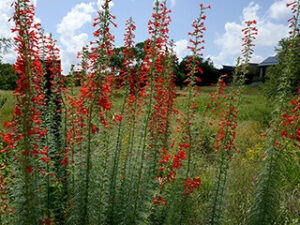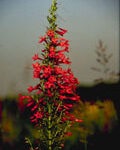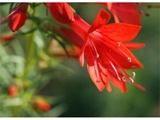 by CMG Betty J
by CMG Betty J
Standing Cypress, Ipomopsis rubra, is a biennial wildflower found in the northern two-thirds of the Hill Country. Its native range spreads from central Texas, north to Kentucky and east to North Carolina. Also known as Texas Plume, Red Texas Star, and Red Gilia, it grows well in rocky sand or loam, and prefers full sun to light shade. In its first year after planting, it forms a low rosette with fernlike leaves. In its second growing season, it sends up simple, unbranched stems 2’ – 5’ tall and then blooms in May and June.

Standing Cypress Stem
The red flowers are tubular, about 1 ½’ long and ¾’ wide. Each spike has many flowers. Its leaves are 1 ½’ long and divided into threadlike segments.
Standing Cypress is easy to cultivate from seed in a residential garden. Plant them against a fence or in a bunch where their height and showy flowers will be best appreciated. After the stalk is finished blooming, it can be cut off to allow a new stem to grow and bloom. However, if the intent is to let the plant reseed, leave the stems and flowers to dry naturally and it will disperse its seeds for next year’s rosettes. First year rosettes are also available from commercial nurseries for transplanting. Texas Plume’s trumpet-like flowers are very attractive to hummingbirds and bees. The plants are moderately deer resistant.

Standing Cypress Flower